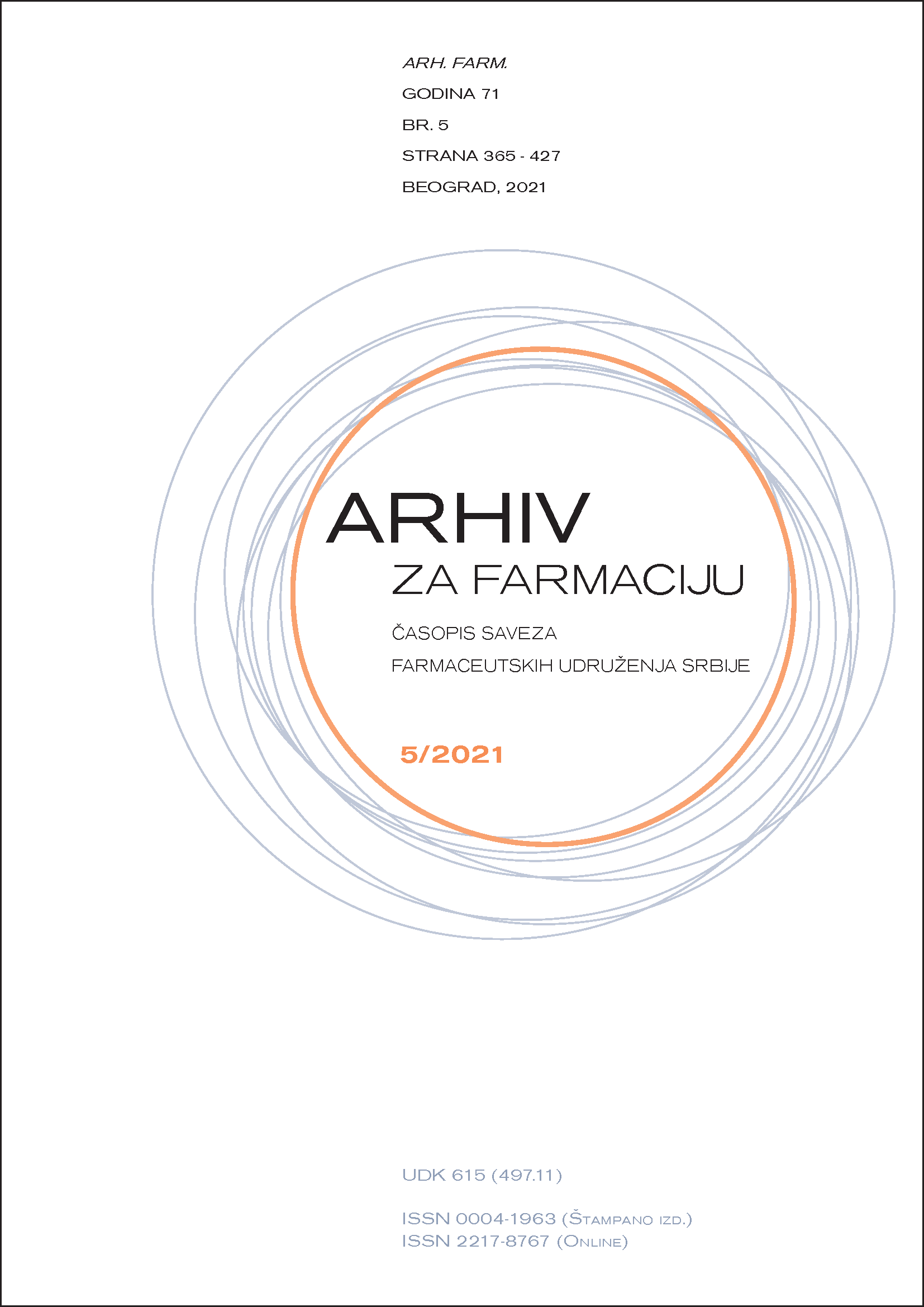Stavovi starijih osoba prema interprofesionalnoj kooperaciji i kolaborativnoj farmaceutskoj praksi: Razvoj upitnika
Sažetak
Starenje populacije se odvija po najvišoj stopi u istoriji, vodeći do povećanja morbiditeta. Stoga se od povećanja nivoa kolaborativne farmaceutske prakse (CPP) i interprofesionalne kolaboracije (IPC) očekuje da dovedu do neophodnog povećanja performansi sistema zdravstvene zaštite. Da bi se poboljšala literatura fokusirana na CPP i IPC, neophodno je da se sprovode istraživačke studije sa jasno definisanim metodama, koje koriste upitnike dobro razvijenih psihometrijskih karakteristika. S tim u vezi, cilj studije je bio da se razvije upitnik za istraživanje stavova starijih osoba (65+) prema IPC i CPP. Koristeći Delfi metod, tim stručnjaka (n=8) je tokom četiri sastanka razvio strukturirani upitnik. Analiza pouzdanosti, korelacija pitanja i faktorska analiza bile su korišćene za validaciju upitnika. Validacija upitnika (n=40) utvrdila je visoku vrednost Kronbahovog koeficijenta od 0.774, dok je analiza pouzdanosti skala na ukupnom uzorku (n=185) prikupljenom iz pet Gerontoloških centara potvrdila relativno visoku vrednost Kronbahovoh koeficijenta od 0.736. Vrednosti intraklasnog koeficijenta korelacije bile su visoko značajne (ICC = 0.749; p < 0.01), što potvrđuje kompaktnost i visoku pouzdanost ovog dela upitnika. Eksploratorna faktorska analiza (EFA) izdvojila je 2 značajna faktora koji objašnjavaju približno 53% varijabiliteta celog modela. Prikladnost razvijenog upitnika potvrđena je validacijom upitnika (n=40) i analizom na ukupnom uzorku (n=185).
Reference
Eurostat. Population structure and ageing. Luxembourg: Eurostat. 2017. [Cited 2018 July 27]. Available from:
http://ec.europa.eu/eurostat/statistics-explained/index.php/Population_structure_and_ageing.
United Nations. Department of Economic and Social Affairs, Population Division. World Population Ageing 2015. New York: United Nations. 2015. [Cited 2017 Apr 10] Available from: http://www.un.org/en/development/desa/population/publications/pdf/ageing/WPA2015_Report.pdf.
World Health Organization. Health aging topic. Geneva: World Health Organization. 2017. [Cited 2017 Sep 04]. Available from: http://www.who.int/topics/ageing/en/.
World Health Organization. Global strategy and action plan on aging and health (2016-2020): A Framework for Coordinated Global Action by the World Health Organization, Member States and Partners across the Sustainable Development Goals. Geneva: World Health Organization. 2016. [Cited 2018 Nov 29]. Available from: http://www.who.int/ageing/GSAP-Summary-EN.pdf?ua=1.
Ferrucci L, Giallauria F, Guralnik JM. Epidemiology of Aging. Radiol Clin North Am. 2008;46:643–652.
Ilić V, Tasić L, Marinković V. Research on the attitudes of the elderly towards interprofessional cooperation and collaborative pharmacy practices: Cross-sectional study in Serbia. Indian J Pharm Educ. 2021;55(1):276-87.
Thannhauser J, Russell-Mayhew S, Scott C. Measures of interprofessional education and collaboration. J Interprof Care. 2010;24:336–349.
Lindqvist S, Duncan A, Shepstone L, Watts F, Pearce S. Development of the “Attitudes to Health Professionals Questionnaire” (AHPQ): A measure to assess interprofessional attitudes. J Interprof Care. 2005;19:269–279.
Körner M. Interprofessional teamwork in medical rehabilitation: a comparison of multidisciplinary and interdisciplinary team approach. Clin Rehabil. 2010;24:745–755.
Parsell G, Bligh J. The development of a questionnaire to assess the readiness of health care students for interprofessional learning (RIPLS). Med Educ. 1999;33:95–100.
Ponzer S, Hylin U, Kusoffsky A, Lauffs M, Lonka K, Mattiasson AC, et al. Interprofessional training in the context of clinical practice: goals and students' perceptions on clinical education wards. Med Educ. 2004;38:727-736.
Rattray J, Jones MC. Essential elements of questionnaire design and development. J Clin Nurs. 2007;16:234–243.
Nuño Solinís R, Berraondo Zabalegui I, Sauto Arce R, San Martín Rodríguez L, Toro Polanco N. Development of a questionnaire to assess interprofessional collaboration between two different care levels. Int J Integr Care. 2013;13: e015.
Jokovic A, Locker D, Stephens M, Kenny D, Tompson B, Guyatt G. Validity and Reliability of a Questionnaire for Measuring Child Oral-health-related Quality of Life. J. Dent. Res. 2002;81:459–463.
Juniper EF, Buist AS, Cox FM, Ferrie PJ, King DR.. Validation of a Standardized Version of the Asthma Quality of Life Questionnaire. Chest. 1999;115:1265–1270.
Black N, Varaganum M, Hutchings A. Relationship between patient reported experience (PREMs) and patient reported outcomes (PROMs) in elective surgery. BMJ Qual Saf. 2014;23:534–542.
Whelan P, Andrews T, Patel S, Lewis A. Taking the Cinderella speciality to the PROM: developing a patient related outcome measure for an older adult mental health service. Qual Ageing Older Adults. 2010;11:51–55.
Singer SJ, Burgers J, Friedberg M, Rosenthal MB, Leape L, Schneider E. Defining and Measuring Integrated Patient Care: Promoting the Next Frontier in Health Care Delivery. Med Care Res Rev. 2010;68:112–127.
Ilic V, Marinkovic V, Tasic L. Conceptual model of collaborative pharmaceutical practice in healthcare and social care for the elderly. Vojnosanit Pregl. 2018;75:1020-1029.
Diamond IR, Grant RC, Feldman BM, Pencharz PB, Ling SC, Moore AM, et al. Defining consensus: a systematic review recommends methodologic criteria for reporting of Delphi studies. Journal of clinical epidemiology. 2014 Apr 1;67(4):401-9.
Tsang S, Royse CF, Terkawi AS. Guidelines for developing, translating, and validating a questionnaire in perioperative and pain medicine. Saudi journal of anaesthesia. 2017 May;11(Suppl 1):S80.
Perneger TV, Courvoisier DS, Hudelson PM, Gayet-Ageron A. Sample size for pre-tests of questionnaires. Quality of Life Research. 2015 Jan;24(1):147-51.
Pejin SL, Bajec J. ESPN Thematic Report on Challenges in long-term care-Serbia. Brussels: European Commission. 2018. [cited 2020 May 2]. Available from: https://ec.europa.eu/social/main.jsp?pager.offset=20&catId=792&langId=en&moreDocuments=yes.
Sauer M, Perišić N. Local Networks in the Provision of Long-term Care Services in Serbia – a View from the South-East of Europe. Sozialer Fortschritt. 2014;63(8):209-15.
Mccallin A. Interdisciplinary practice - a matter of teamwork: an integrated literature review. J Clin Nurs. 2001;10:419–428.
San Martín-Rodríguez L, Beaulieu M-D, D’Amour D, et al. The determinants of successful collaboration: A review of theoretical and empirical studies. J Interprof Care. 2005;19:132–147.
- Autori zadržavaju autorska prava i pružaju časopisu pravo prvog objavljivanja rada i licenciraju ga "Creative Commons Attribution licencom" koja omogućava drugima da dele rad, uz uslov navođenja autorstva i izvornog objavljivanja u ovom časopisu.
- Autori mogu izraditi zasebne, ugovorne aranžmane za neekskluzivnu distribuciju članka objavljenog u časopisu (npr. postavljanje u institucionalni repozitorijum ili objavljivanje u knjizi), uz navođenje da je članak izvorno objavljen u ovom časopisu.
- Autorima je dozvoljeno i podstiču se da postave objavljeni članak onlajn (npr. u institucionalni repozitorijum ili na svoju internet stranicu) pre ili tokom postupka prijave rukopisa, s obzirom da takav postupak može voditi produktivnoj razmeni ideja i ranijoj i većoj citiranosti objavljenog članka (Vidi Efekti otvorenog pristupa).

